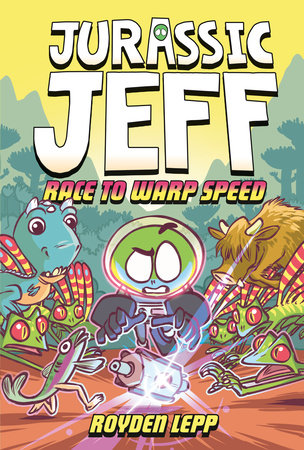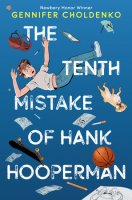We have a problem in our house with books. Specifically, the reading of books. I know as a book blogger I should be decidedly pro-reading-of-books, but my wife and I have some safety concerns. Books can and should be read on couches, chairs, in beds, even on swings for especially adventurous types. But our boys

one of my boys demonstrating the safety hazard of a good book
have developed the troubling habit of reading particularly engaging books while walking, eating, and most recently while traveling on staircases. Only the most exciting stories pose this risk, but with authors like Royden Lepp creating hilarious and unique graphic novels like the Jurassic Jeff series, it might be time for a family intervention.
Royden is exactly the kind of author I’m worried about — someone who has a long history of producing highly engaging and creative work like the RUST series, as well as a huge range of creative offerings and a seemingly endless list of new ideas and concepts. With Jurassic Jeff, Royden blends dinosaurs, aliens, and world domination into an unputdownable middle grade comedy.
 And much to the excitement of our boys, I recently had the opportunity to ask Royden some questions about his latest venture into the world of graphic novels. Our interview is below, and while I neglected to ask him for advice about our risky reading dilemma, his insights about the creative process are absolutely worth a look!
And much to the excitement of our boys, I recently had the opportunity to ask Royden some questions about his latest venture into the world of graphic novels. Our interview is below, and while I neglected to ask him for advice about our risky reading dilemma, his insights about the creative process are absolutely worth a look!
Chris: Thanks for making some time to chat with me, Royden! Jurassic Jeff is such a fun series — what gave you the idea?
Royden: I love mashing up genre’s and settings. This is a weird one, but I was sitting in a church listening to someone talk and I was doodling in the hand out paper (I like to draw while I listen to people talk). I drew an alien emerging from a flying saucer, surrounded by dinosaurs and I thought “huh, that’s kind of a fun idea”.

Royden: Yeah, Jurassic Jeff is my first foray into comedy and middle grade. I wanted to experiment with serial content and comedy and Jurassic Jeff has been a really fun and interesting exploration into another side of me as an author. But honestly I had a son entering middle grade and I was reading some of the books he brought home. Some of them were good but some made me kinda think ‘well I could do that’. My son has a great sense of humor, so I’m always trying to see if I can make him laugh with these stories.
Chris: Well it’s certainly been a hit with the boys in my house! You seem to like blending themes of old and new (I’m thinking especially of the Rust series here)…are there other themes that show up across different projects?
Royden: I’ve never realized that but I suppose it’s true. I think there is some strong imagery across a lot of my projects; young male characters in an adventure or a fight for their lives. Nature, animals, creatures, monsters, robots, and bugs. I love that stuff.
Chris: Well, you also give yourself a lot of options by working in so many different mediums (illustration, video, photography)…do you have a favorite? How did you go about learning so many different artistic formats?
Royden: I must get bored! I think there are mediums that I find so compelling that I can’t stay away from them. Photography was a really nice divergence from drawing and comics in my early 20’s. It’s such a refreshing art form. Photography led very naturally into videography. And strangely it’s all had an influence on my drawings. In RUST I would often think about the shutter speed or the aperture setting of the image I was working on. I also have a very encouraging and supportive wife that pushes me into exploring things.
them. Photography was a really nice divergence from drawing and comics in my early 20’s. It’s such a refreshing art form. Photography led very naturally into videography. And strangely it’s all had an influence on my drawings. In RUST I would often think about the shutter speed or the aperture setting of the image I was working on. I also have a very encouraging and supportive wife that pushes me into exploring things.
Chris: Well, speaking of exploring new things, I’d love to get your thoughts about the role of AI in the world of writing and illustration. Could you speak to the potential benefits and drawbacks as generative AI becomes more prevalent in the industry?
Royden: Yeah, everything is about to change drastically. I feel the giant ship of culture creaking and groaning as it starts to head in a new direction. I won’t lie, I’m a bit scared at the moment. Change is hard. But for now I can only keep doing what I love to do; tell stories. I hope A.I. makes it easier for me to get a book done and I hope it doesn’t discourage those who are looking forward to telling their own stories, making their own art. But ultimately, fear of the future is not the way for us to live.
Chris: Well said, and certainly something us creative folks need to hear! So, what’s next for you as an author? Can you give us any clues about new projects you’re working on?
Royden: I just found a home for a really special project that I wrote during the pandemic. I’m elated that it’s going to live a life off my hard drive and in the hands of readers. That’s all I can say about it at the moment but it’s a really special story.
Chris: Well I can’t wait to learn more! Okay…now for the lighting round:
Favorite place to write?
Ideally; Vancouver island staring out at the ocean. Realistically; in my living room with my family (but with headphones on).
Favorite authors?
I’ll say biggest influences; Michel Gagne, Jake Parker, Kazu Kibuishi, Doug Tenapel.
Best dessert?
Baklava
Do you have any pets?
Yes, at the moment my son and I are keeping a leopard gecko named Tang, and two different species of praying mantis, a ghost, and a blue papua giant. The ghost mantis is getting ready to lay eggs.
Favorite elementary school memory?
Running through the woods as fast as my lungs would let me.
Favorite dinosaur?
The Quetzalcoatlus is the most insane creature I’ve ever imagined. A flying reptile the size of a giraffe!?
Favorite piece of advice for other writers:
Find your voice. Other people might write or draw like you but only you can be YOU. Find out what makes your voice unique and lean into it. There’s nobody out there like you.
Huge thanks to Royden Lepp for the interview! Jurassic Jeff: Race to Warp Speed is available now from Penguin Random House. Until next time!


 I’ve been a fan of Gennifer Choldenko since I first read Al Capone Does My Shirts (a 2005 Newbery Honor Book). I also had the pleasure of attending a writing revision session she was giving at a national writing conference.
I’ve been a fan of Gennifer Choldenko since I first read Al Capone Does My Shirts (a 2005 Newbery Honor Book). I also had the pleasure of attending a writing revision session she was giving at a national writing conference. About the Author
About the Author
 Breaking Into Sunlight by John Cochran, Algonquin Young Reader, 2024 One in eight young people in the US live with a parent who has a substance abuse problem. This story tackles what happens when Reece’s dad overdoses and his mother leaves him. Spending the summer in a grubby trailer park far from home, he explores the local river with new friends who understand his struggles all too well. This is Cochran’s debut novel.
Breaking Into Sunlight by John Cochran, Algonquin Young Reader, 2024 One in eight young people in the US live with a parent who has a substance abuse problem. This story tackles what happens when Reece’s dad overdoses and his mother leaves him. Spending the summer in a grubby trailer park far from home, he explores the local river with new friends who understand his struggles all too well. This is Cochran’s debut novel.
 The New Girl by Cassandra Calin, Scholastic graphix, 2024. I love a good immigration story; this one is a graphic novel about a girl who moves from Romania to Canada. The art is appealing and the story line is refreshingly honest about periods and girl crushes and forging friendships among kids who speak different languages. There’s a glossary at the back and the story reflects the author’s own experience.
The New Girl by Cassandra Calin, Scholastic graphix, 2024. I love a good immigration story; this one is a graphic novel about a girl who moves from Romania to Canada. The art is appealing and the story line is refreshingly honest about periods and girl crushes and forging friendships among kids who speak different languages. There’s a glossary at the back and the story reflects the author’s own experience. The Queen’s English: the young readers LGBTQIA+ dictionary of lingo and colloquial phrases by Chloe O. Davis, S&S, 2024 Here’s a handy resource to words and phrases often used in the queer context. It’s very straightforward language in a visually appealing format and will be a great reference for both schools and families.
The Queen’s English: the young readers LGBTQIA+ dictionary of lingo and colloquial phrases by Chloe O. Davis, S&S, 2024 Here’s a handy resource to words and phrases often used in the queer context. It’s very straightforward language in a visually appealing format and will be a great reference for both schools and families.